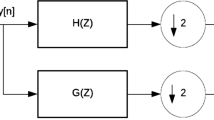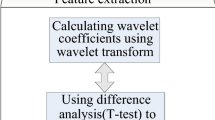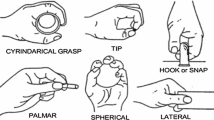Abstract
Few studies in the literature have researched the use of surface electromyography (sEMG) for motor assessment post-stroke due to the complexity of this type of signal. However, recent advances in signal processing and machine learning have provided fresh opportunities for analyzing complex, non-linear, non-stationary signals, such as sEMG. This paper presents a method for identification of the upper limb movements from sEMG signals using a combination of digital signal processing, that is discrete wavelet transform, and the enhanced probabilistic neural network (EPNN). To explore the potential of sEMG signals for monitoring motor rehabilitation progress, this study used sEMG signals from a subset of movements of the Arm Motor Ability Test (AMAT) as inputs into a movement classification algorithm. The importance of a particular frequency domain feature, that is the ratio of the mean absolute values between sub-bands, was discovered in this work. An average classification accuracy of 75.5% was achieved using the proposed approach with a maximum accuracy of 100%. The performance of the proposed method was compared with results obtained using three other classification algorithms: support vector machine (SVM), k-Nearest Neighbors (k-NN), and probabilistic neural network (PNN) in terms of sEMG movement classification. The study demonstrated the capability of using upper limb sEMG signals to identify and distinguish between functional movements used in standard upper limb motor assessments for stroke patients. The classification algorithm used in the proposed method, EPNN, outperformed SVM, k-NN, and PNN.




Similar content being viewed by others
References
Ahmadlou, M., and Adeli, H., Enhanced probabilistic neural network with local decision circles: A robust classifier. Integr Comput-Aided Eng. 17(3): 197–210, 2010. https://doi.org/10.3233/ICA-2010-0345.
Alexandridis, A., Paizis, E., Chondrodima, E., and Aliaj, E., A particle swarm optimization approach in printed circuit board thermal design. Integr. Comput-Aided Eng. 24(2):143–155, 2017.
Amezquita-Sanchez, J. P., Adeli, A., and Adeli, H., A new methodology for automated diagnosis ofmild cognitive impairment (MCI) using magnetoencephalography (MEG). Behav. Brain Res. 305:174–180, 2016. https://doi.org/10.1016/j.bbr.2016.02.035.
Ansari, A. H., Cherian, P. J., Caicedo, A., Naulaers, G., De Vos, M., and Van Huffel, S., Neonatal seizure detection using deep convolutional neural networks, Int. J. Neural Syst. 29(4):1850011, 2019.
Atzori, M., Gijsberts, A., Castellini, C., Caputo, B., Hager, A.-G. M., Elsig, S., and Müller, H., Electromyography data for non-invasive naturally-controlled robotic hand prostheses. Sci Data. 1:140053, 2014. https://doi.org/10.1038/sdata.2014.53.
Atzori, M., Cognolato, M., and Müller, H., Deep learning with convolutional neural networks applied to electromyography data: A resource for the classification of movements for prosthetic hands. Front. Neurorobot. 10(SEP), 1–10, 2016. https://doi.org/10.3389/fnbot.2016.00009.
Cesqui, B., Tropea, P., Micera, S., and Krebs, H. I., EMGbased pattern recognition approach in post stroke robot-aided rehabilitation:a feasibility study. J. Neuroeng. Rehabil, 10(1):75, 2013. https://doi.org/10.1186/1743-0003-10-75.
Chen, M., Zhang, X., Lu, Z., Li, X., and Zhou, P., Two-source validation of progressive fastica peel-off for automatic decomposition of high density surface EMG. Int. J. Neural Syst. 28:9 (14 pages), 2018.
Chu, J. U., Moon, I., and Mun, M. S., A real-time EMG pattern recognition system based on linear-nonlinear feature projection for a multifunction myoelectric hand. IEEE Trans. Biomed. Eng. 53(11):2232–2239, 2006 https://doi.org/10.1109/TBME.2006.883695.
Dai, H. and Cao, Z., A wavelet support vector machine based neural network meta model for structural reliability assessment. Comput-Aided Civ. Infrastruct. Eng. 32(4):344–357, 2017.
Dai C., and Hu, X., Extracting and classifying spatial muscle activation patterns in flexor digitorum superficialis using high-density electromyogram recordings. Int. J. Neural Syst. 29(1): 1850025 (15 pages), 2019.
Dewald, J. P., Pope, P. S., Given, J. D., Buchanan, T. S., and Rymer, W. Z., Abnormal muscle coactivation patterns during isometric torque generation at the elbow and shoulder in hemiparetic subjects. Brain. 118(Pt 2):495–510, 1995. https://doi.org/10.1093/brain/118.2.495.
Gaur, P., McCreadie, K., Pachori, R. B., Wang, H., and Prasad, G., Tangent space feature-based transfer learning classification model for two-class motor imagery brain-computer interface. Int. J. Neural Syst. 29(10):19500215 (17 pages), 2019.
George, S. H., Rafiei, M. H., Borstad, A., Gauthier, L., Buford, J. A., and Adeli, H., Computer-aided prediction of extent of motor recovery following constraint-induced movement therapy in chronic stroke. Behav. Brain Res. 327:191–199, 2017.
Ghosh-Dastidar, S., Adeli, H., and Dadmehr, N., Principal component analysis-enhanced cosine radial basis function neural network for robust epilepsy and seizure detection. IEEE Trans. Biomed. Eng. 55(2):512–518, 2008.
Gok, S. and Sahin, M., Prediction of forelimb EMGs and movement phases from corticospinal signals in the rat during the reach-to-pull task. Int. J. Neural Syst. 29(7):1950009 (20 pages), 2019.
Gómez-Vilda, P., Gómez-Rodellar, A., Ferrández Vicente, J. M., Mekyska, J., Palacios-Alonso, D., Rodellar-Biarge, V., Álvarez-Marquina, A., Eliasova, I., Kostalova, M., and Rektorova, I., Neuromechanical modelling of articulatory movements from surface electromyography and speech formants. Int. J. Neural Syst. 29(2):1850039 (17 pages), 2019.
Gorriz, J. M., Ramirez, J., Segovia, F., Martinez, F. J., Lai, M. C., Lombardo, M. V., Baron-Cohen, S., and Suckling, J., A machine learning approach to reveal the neuro-phenotypes of autisms. Int. J. Neural Syst.. 1850058:(22 pages), 2019.
Gray, V. L., Ivanova, T. D., and Garland, S. J., A single session of open kinetic chain movements emphasizing speed improves speed of movement and modifies postural control in stroke. Physiother. Theory Pract.. 614: 1–11, 2016. https://doi.org/10.3109/09593985.2015.1110848.
Gresham, G., Duncan, P., and Stason, W., Post-stroke rehabilitation. Darby, PA: Diane Publishing, 2004.
Hayward, K. S., Eng, J. J., Boyd, L. A., Lakhani, B., Bernhardt, J., and Lang, C. E., Exploring the role of accelerometers in the measurement of real world upper-limb use after stroke. Brain Impair. 1(314):1–18, 2015. https://doi.org/10.1017/BrImp.2015.21.
Hirschauer, T. J., Adeli, H., and Buford, J. A., Computer-aided diagnosis of parkinson’s disease using enhanced probabilistic neural network. J. Med. Syst. 39(11), 2015. https://doi.org/10.1007/s10916-015-0353-9.
Hua, C., Wang, H., Wang, H., Lu, S., Liu, C., and Khalid, S. M., A Novel method of building functional brain network using deep learning algorithm with application in proficiency detection. Int. J. Neural Syst.. 29(1):1850015 (17 pages), 2019.
Huang, Y., and Beck, J. L., Full Gibbs sampling procedure for Bayesian system identification incorporating sparse Bayesian learning with automatic relevance determination. Comput-Aided Civ. Infrastruct. Eng. 33(9):712–730, 2018.
Khedher, L., Illan, I. A., Gorriz, J. M., Ramirez, J., Brahim, A., and Meyer-Baese, A., Independent component analysis-support vector machine-based computer-aided diagnosis system for alzheimer's with visual support. Int. J. Neural Syst. 27:3, 1650050 (18 pages), 2017.
Klomp, A., and Van der Krogt, J., Design of a concise and comprehensive protocol for post stroke neuromechanical assessment. J. Bioeng. Biomed. Sci. (January 2011), 1–8, 2012. https://doi.org/10.4172/2155-9538.S1-008.
Lambach, R. L., Young, J. W., Flanigan, D. C., Siston, R. A., and Chaudhari, A. M. W., Knee joint loading during lineman-specific movements in american football players. 142–148, 2015.
Leuenberger, K., Gonzenbach, R.,Wachter, S., Luft, A., and Gassert, R., A method to qualitatively assess arm use in stroke survivors in the home environment. Med. Biol. Eng. Comput. 55(1), 1–10, 2016. https://doi.org/10.1007/s11517-016-1496-7.
Li, Z., Guiraud, D., Andreu, D., Gelis, A., Fattal, C., and Hayashibe, M., Real-time closed-loop functional electrical stimulation control of muscle activation with evoked electromyography feedback for spinal cord injured patients. Int. J. Neural Syst. 28(6):1750063 (14 pages), 2018.
Liu, J., Kang, S. H., Xu, D., Ren, Y., Lee, S. J., and Zhang, L. Q., EMG-Based continuous and simultaneous estimation of arm kinematics in able-bodied individuals and stroke survivors. Front. Neurosci. 11(August):1–11, 2017. https://doi.org/10.3389/fnins.2017.00480.
Lorussi, F., Nicola, C., De Rossi D., Paradiso, R., Veltink, P., and Tognetti, A., Wearable textile platform for assessing stroke patient treatment in daily life conditions. Front. Bioeng. Biotechnol. 4:28, 2016.
Ma, X., Yu, N., and Zhou, W., Using dictionary pair learning for seizure detection, Int. J. Neural Syst. 29(4)1850005 (14 pages), 2019.
Manzanera, M. O., Meles, S. K., Leenders, K. L., Renken, R. J., Pagani, M., Arnaldi, D., Nobili, F., Obeso, J., Oroz, M. R., Morbelli, S., and Maurits, N. M., Scaled subprofile modeling and convolutional neural networks for the identification of Parkinson’s disease in 3D nuclear imaging data. Int. J. Neural Syst. 29(9):1950010 (15 pages), 2019.
Martinez-Mozos, O., Sandulescu, V., Andrews, S., Bellotto, N., Dobrescu, R., and Ellis, D., Stress detection using wearable physiological and sociometric sensors. Int. J. Neural Syst. 27:2, 1650041 (16 pages), 2017.
Martinez-Murcia, F.J., Gorriz, J.M., Ramirez, J., and Ortiz, A., Convolutional neural networks for neuroimaging in parkinson’s disease: is preprocessing needed?. Int. J. Neural Syst. 28(10):1850035 (18 pages), 2018.
Masse, F., Gonzenbach, R., Paraschiv-Ionescu, A., Luft, A., and Aminian, K., Wearable barometric pressure sensor to improve postural transition recognition of mobility – impaired stroke patients. IEEE Trans. Neural Syst. Rehabil. Eng. 24(11): 1210–1217, 2016. https://doi.org/10.1109/TNSRE.2016.2532844.
Molina-Cabello, M. A., Luque-Baena, R. M., López-Rubio, E., and Thurnhofer-Hemsi, K., Vehicle type detection by ensembles of convolutional neural networks operating on super-resolved images. Integr. Comput-Aided Eng. 25(4:321–333, 2018.
O’Dell, M. W., Kim, G., Rivera, L., Fieo, R., Christos, P., Polistena, C., Fitzgerald, K., and Gorga, D., A psychometric evaluation of the arm motor ability test. J Rehabil Med. 45(6):519–527, 2013.
Patel, S., Hughes, R., and Hester, T., A novel approach to monitor rehabilitation outcomes in stroke survivors using wearable technology. Proc. IEEE. 98(3):450–461, 2010. https://doi.org/10.1109/JPROC.2009.2038727.
Phinyomark, A., Quaine, F., Charbonnier, S., Serviere, C., Tarpin-Bernard, F., and Laurillau, Y., EMG feature evaluation for improving myoelectric pattern recognition robustness. Expert Syst. Appl. 40(12):4832–4840, 2013. https://doi.org/10.1016/j.eswa.2013.02.023.
Ramos-Murguialday, A., Broetz, D., Rea, M., Läer, L., Yilmaz, O., Brasil, F. L., and Birbaumer, N., Brain–machine interface in chronic stroke rehabilitation: A controlled study. Ann. Neurol. 74(1), 100–108, 2013.
Rembado, I., Castagnola, E., Turella, L., Ius, T., Budai, R., Ansaldo, A., Angotzi, G.N., de Bertoldi, F., Ricci, D., Skrap, M., and Fadiga, L., Independent component decomposition of human somatosensory evoked potentials recorded by micro-electrocorticography. Int. J. Neural Syst. 27(4):1650052 (16 pages), 2017.
Sankari, Z. and Adeli, H., Probabilistic neural networks for EEG-based diagnosis of alzheimer’s disease using conventional and wavelet coherence. J. Neurosci. Methods. 197(1):165–170, 2011.
Sengur, A., Akbulut, Y., Guo, Y., and Bajaj, V., Classification of amyotrophic lateral sclerosis disease based on convolutional neural network and reinforcement sample learning algorithm. Health Inf. Sci. Syst. 5(1): 9, 2017. https://doi.org/10.1007/s13755-017-0029-6.
Subasi, A. (2012). Classification of EMG signals using combined features and soft computing techniques. Appl Soft Comput J, 12(8), 2188–2198. https://doi.org/10.1016/j.asoc.2012.03.035.
Thielbar, K. O., Triandafilou, K. M., Fischer, H. C., O’Toole, J. M., Listenberger, M. L., Ochoa, J. M., Kamper, D. G. Benefits of using a voice and EMG-driven actuated glove to support occupational therapy for stroke survivors. IEEE Trans. Neural Syst. Rehabil. Eng. 4320(c):1–1, 2016. https://doi.org/10.1109/TNSRE.2016.2569070.
Torres, J. F., Galicia, A., Troncoso, A., and Martínez-Álvarez, F., Ascalable approach based on deep learning for big data time series forecasting. Integr. Comput-Aided Eng. 25(4):335–348, 2018.
Tosin, M. C., Majolo, M., Chedid, R., Cene, V. H., and Balbinot, A., SEMG feature selection and classification using SVMRFE. Proceedings of the Annual International Conference of the IEEE Engineering in Medicine and Biology Society, EMBS. 390–393, 2017. https://doi.org/10.1109/EMBC.2017.8036844.
Twitchell, T. E., The restoration of motor function following hemiplegia in man. Brain. 74(4): 443–480, 1951.
Vera-Olmos, F. J., Pardo, E., Melero, H., and Malpica, N. (2019), DeepEye: Deep convolutional network for pupil detection in real environments, Integr. Comput-Aided Eng. 26(1): 85–95.
Wang, P., and Bai, X. (2018). Regional parallel structure based CNN for thermal infrared face identification. Integr. Comput-Aided Eng. 25(3):247–260.
Wang, S., Hu, Y., Shen, Y., and Li, H., classification of diffusion tensor metrics for the diagnosis of a myelopathic cord using machine learning. Int. J. Neural Syst. 28(2), 2018.
Wei, J., Meng, Q., and Badii, A., Classification of human hand movements using surface EMG for myoelectric control. Adv. Intell. Syst. Comput. 513:331–339, 2017. https://doi.org/10.1007/978-3-319-46562-3_22.
Wolf, S., Winstein, C., Miller, J., Thompson, P., Taub, E., and Uswatte, G. (2008). The Excite trial: retention of improved upper extremity function among stroke survivors receiving CI Movement therapy. Lancet Neurol., 7(1):33–40. https://doi.org/10.1016/S1474-4422(07)70294-6.
Wu, Q., Mao, J. F.,Wei, C. F., Fu, S., Law, R., Ding, L., … and Yang, C.H., Hybrid BF-PSO and fuzzy support vector machine for diagnosis of fatigue status using EMG signal features. Neurocomputing. 173:483–500, 2016. https://doi.org/10.1016/j.neucom.2015.06.002.
Wu, Q., Zhang, Y., Liu, J., Sun, J., and Cichocki, A., Regularized group sparse discriminant analysis for P300-based brain computer interface. Int. J. Neural Syst. 29(6):1950002 (15 pages), 2019.
Xia, P., Hu, J., and Peng, Y., EMG-based estimation of limb movement using deep learning with recurrent convolutional neural networks. Artif. Organs. 42(5):E67–E77, 2018. https://doi.org/10.1111/aor.13004.
Xue, Y. D. and Li, Y. C., A Fast detection method via region-based fully convolutional neural networks for shield tunnel lining defects. Comput-Aided Civ. Infrastruct. Eng. 33(8):638–654, 2018.
Yang, X., Li, H., Yu, Y., Luo, X., Huang, T., Yang, X., and Yang, X., Automatic pixel-level crack detection and measurement using fully convolutional network. Comput-Aided Civ. Infrastruct. Eng. 33:12, 2018.
Yang, T., Cappelle, C., Ruichek, Y., and El Bagdouri, M., Multi-object tracking with discriminant correlation filter based deep learning tracker. Integr. Comput-Aided Eng. 26(3):273–284, 2019.
Yu, B., Wang, H., Shan, W., and Yao, B. Prediction of bus travel time using random forests based on near neighbors. Comput-Aided Civ. Infrastruct. Eng. 33(4):333–350, 2018.
Zhang, Z., Fang, Q., and Gu, X., Objective assessment of upper limb mobility for post-stroke rehabilitation. IEEE Trans. Biomed. Eng. 63(4):859–868, 2016. https://doi.org/10.1109/TBME.2015.2477095.
Zhang, Y., Wang, Y., Jin, J., and Wang, X. Sparse Bayesian Learning for obtaining sparsity of EEG frequency bands based feature vectors in motor imagery classification. Int. J. Neural Syst. 27(2):1650032 (13 pages), 2017.
Zhang, X., Foderaro, G., Henriquez, C., and Ferrari, S., A scalable weight-free learning algorithm for regulatory control of cell activity in spiking neuronal networks. Int. J. Neural Syst. 28(2):1750015, 2018. https://doi.org/10.1142/S0129065717500150.
Zhang, J., Xiao, M., Gao, L., Chu, S., Probability and interval hybrid reliability analysis based on adaptive local approximation of projection outlines using support vector machine. Comput-Aided Civ. Infrastruct. Eng. 34(11):991–1009, 2019.
Author information
Authors and Affiliations
Corresponding author
Ethics declarations
Authors declare that they have no conflict of interest. Authors did not collect data from humans or animals. Data used in this research are from publicly-available sources.
Additional information
Publisher’s Note
Springer Nature remains neutral with regard to jurisdictional claims in published maps and institutional affiliations.
This article is part of the Topical Collection on Image & Signal Processing
Appendix 1
Appendix 1
Rights and permissions
About this article
Cite this article
Burns, A., Adeli, H. & Buford, J.A. Upper Limb Movement Classification Via Electromyographic Signals and an Enhanced Probabilistic Network. J Med Syst 44, 176 (2020). https://doi.org/10.1007/s10916-020-01639-x
Received:
Accepted:
Published:
DOI: https://doi.org/10.1007/s10916-020-01639-x




